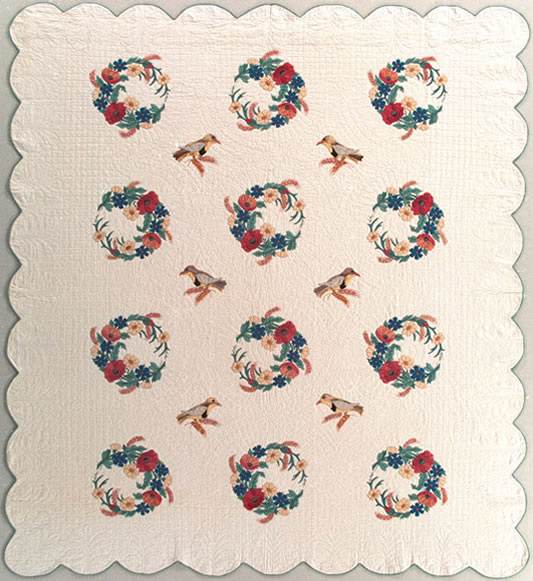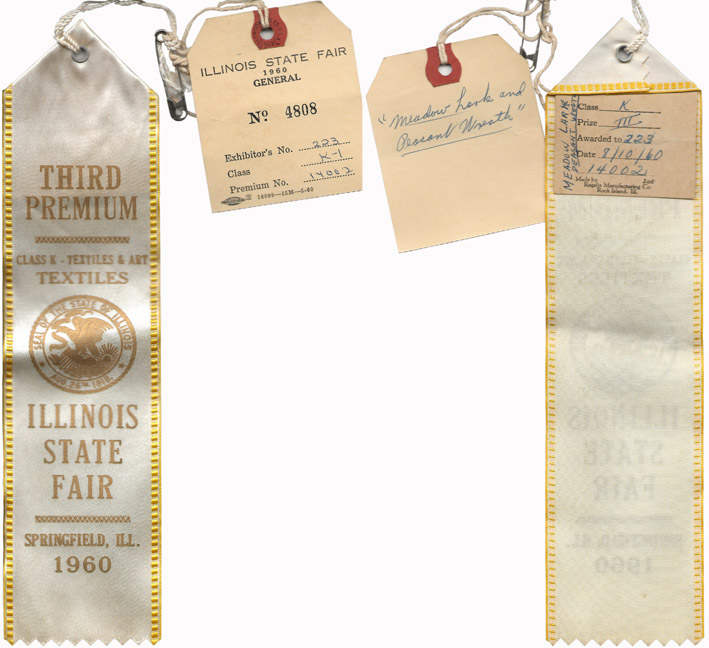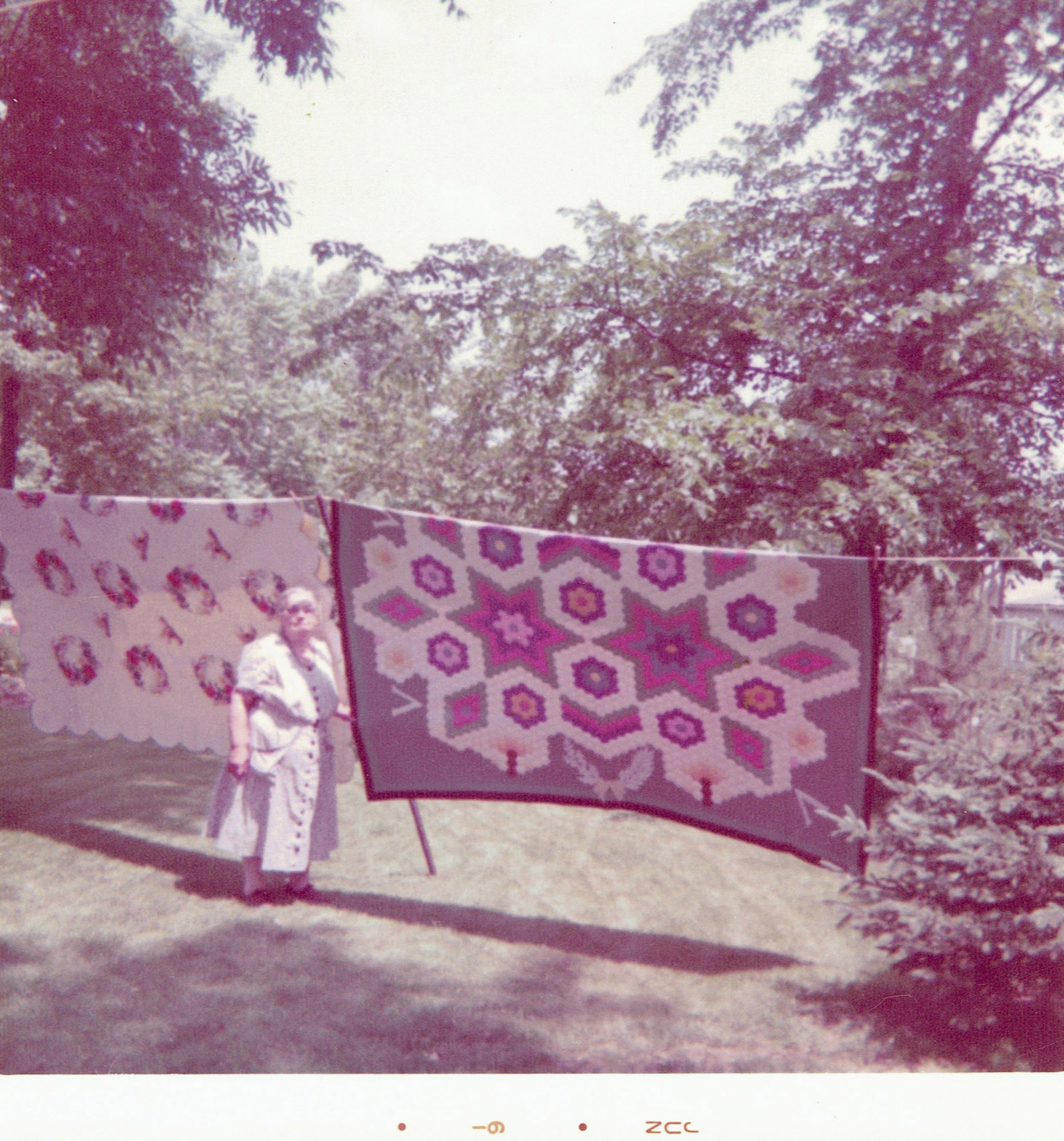BACK TO QUILTS
Meadow Lark and Peasant Wreath; Wild Flower Wreath; Field Flower Wreath, Field Flowers
CITE THIS QUILT

QUILT INDEX RECORD
18-14-30
Description:
This late 1930s quilt Paragon kit (Wild Flower Wreath #01010) has been modified by Gasperik who added six meadowlarks from an outside source, plus the embroidered wheat, a Hungarian national emblem that appears on many of her quilts. Its scalloped border is also Gasperik's addition to the Paragon design. Gasperik added to and altered commercial patterns throughout her quilting career.
Essay:
Salser believes that even though this quilt may have been begun close to 1937-38, it wasn’t completed until years later. She believes those meadowlarks were added later, because she remembers her mother making blouses of those woodsy print materials. If the quilt was completed shortly before the 1949 Tuley Park quilt show where her sister remembers it hanging, then she would have been 8 or 9 years old when her mother made the blouses she remembers. That is quite possible. Salser strongly associates this quilt (which is one of her personal Gasperik favorites) with the colorful garden at the house in East Hazelcrest to which the Gasperiks moved in 1948-1949 - and not with the dark cramped quarters behind the store on Cottage Grove. When Salser visited Hungary in 1992 she saw displays of floral embroidered textiles in the Museum of Hungarian Popular Arts and Crafts in Kecskemet, Hungary which are very reminiscent of the red, yellow and blue wildflower wreaths on this quilt. She would like to imagine that the Paragon kit appealed to her grandmother’s Hungarian sensibilities and that even if she began to appliqué it in that dark dining room (there was no window), in making it she was reminding herself of the fields and flowers of the Hungarian plains, which she left behind when she emigrated to Chicago. Lines of quilting run under but not through the meadowlarks. Perhaps after the move to East Hazelcrest, where she finally had a roomy garden, she was inspired to get out that wild flower quilt, to liberate it with those birds and plant it with Hungarian wheat.
It should be noted that the color picture pasted on the Paragon kit #01010 box lid calls the contents "Quilt No. 01010 Wild Flower Wreath Design", where the instruction sheet inside the box describes the contests as "PARAGON Reg. U.S.PAT. OFF. STAMPED QUILT - NO. 01010 "FIELD FLOWER WREATH". The embroidery on the Gasperik quilt follows the Paragon kit instructions. A quilt top sewn by an unknown quilter is embroidered in pretty much the same way and with the same skill. This top was purchased in 2005 by Susan Salser from an ebay seller who described its provenance as follows: "From the Estate of an 87 Year Old Woman. This vintage applique quilt top is 80" wide and 90" long and is in excellent condition with just a few small light age spots. It has 12 appliqued designs of poppys, daiseys and blue flowers I do not recognize. The edges of this quilt top are embroidered with the wording "PARAGON (N.Y.) REG. U.S. PAT. OFF. NO. 01010 QILT EMBROIDER WITH PERLUSTA". It should be noted the company name is stamped not embroidered on the edge of the quilt top, as would be expected. The biggest difference between the Gasperik quilt and the purchased quilt-top is the fabric ground. The Gasperik quilt is now white, but Salser remembers that it had a creamier tone before she washed the quilt. The ebay top Salser purchased is an ivory toned coarser fabric than the percale of the Gasperik quilt. The kit's ground fabric is eggshell or off white in tone. The Gasperik quilt measures 77" x 88" and has been washed. The unwashed ebay quilt top measures 80" by 90".
Earlier, Salser had purchased a copy of Paragon #01010. The seller described the 2003 sale copy as follows: "From a 1937 quilt kit is a pattern for a vintage Wildflower Wreath Quilt, 81" x 94", for a full-sized bed. If you've priced complete and original old kits lately, you're well aware that they have become scarce and expensive to buy. This is not a kit - it is a pattern adapted from one and is complete except for the fabrics. The photo that came with the kit was in black and white, so with it will be a color photo of the complete wreath. It was started and set aside almost 70 years ago, but still has the bright shades of red, blues and yellow.” When the copy of this “Wildflower Wreath Quilt” pattern arrived the instruction sheet began: “These instructions are a replacement for the original sheet that was included in the kit – it was brief and had only a black and white picture of the finished quilt on the envelope. A copy of that photo is included. It also had a sales slip for $5.33 from Marshall Field...” The original Paragon #01010 kit Salser purchased on ebay has a tag affixed to the box cover. She can make out “Boston Store Milwaukee” a price of “$5.60” and the number “01010”. A year is not visible.
The stamped eggshell percale supplied in this kit measures approximately 80” x 96”. Salser believes there is no reason to question that Gasperik probably used the actual Paragon kit contents, but adding appliqué birds and embroidered wheat to the kit’s materials. Since the Gasperik quilt is now so faded from washing and wall display, it is difficult to determine whether Gasperik used the kit’s colored fabrics; but the selection of hues does match; so, again, there is no reason to question that the Gasperik quilt was made from Paragon kit #01010, with some additions and the substitution of a scalloped border for the kit’s straight border. From the price tag information mentioned above, this kit was marketed in 1937. In June 2014 Susan Salser purchased, on eBay, a finished quilt which must have been made from Paragon kit #01010. The eBay seller acquired this unsigned quilt from an estate sale in NY whose seller told her the quilt had been made by her mother years ago. It had been stored in a trunk for years, so the fabric color are still quite vivid. This quilt appears to be a faithful execution of Paragon's kit and the quilt is in excellent condition. According to the website "fabrics.net" (http://info.fabrics.net/history-of-kit-quilts/" in its subsection entitled "Kit Quilts by Individuals" "Paragon made 127 kits from 1937 - 1982 and are still making kits today" (June 123, 2014).
Because the Gasperik quilt's owner, Susan Salser, recognizes fabrics her grandmother (Gasperik) used to make the added meadowlarks as fabrics her own mother used to make blouses for herself ~1950, she believes that this quilt, although it might have been begun as early as 1937 was not completed until over a decade later. This makes sense, in terms of the trajectory of Gasperik's quilting career. In the early years of her quilt-making she seems to have completed quite a few quilt tops which she did not immediately finish. She was working at a furious pace, completely entranced with quilt-making. These tops furnished good projects for her to work on (to complete, or in several cases to decide to leave uncompleted) during the 'dry' years after The Detroit News quilts contests ceased (the final one was held in May 1940) and during the period when, due to WWII, the Illinois State Fairs (Gasperik's second-favorite quilt competition venue) were cancelled (1942 through 1945). This is a time when her quilting skills (and energy) were at their zenith, although her competition opportunities were at their nadir. This is the quilt Susan most admired seeing her grandmother display in her East Hazelcrest garden because of its cheerful and colorful outdoors look. She was very happy when her mother gave it to her as a gift from her grandmother.
Where are the records for this quilt housed?
Mary Gasperik Legacy Project
Who documented this quilt?
Mary Gasperik Private Collection
Gasperik Legacy Project Number:
046
This is a:
Finished quilt
Quilt's title:
Meadow Lark and Peasant Wreath
Owner's name for quilt:
Wild Flower Wreath
Names for quilt's pattern in common use:
Field Flower Wreath, Field Flowers
How wide is the quilt?
77 inches
How long is the quilt?
88 inches
Shape of edge:
Scalloped
Shape of corners:
Scalloped
What color is the quilt?
Beige or Tan; Blue or Navy; Gold; Red; White; Yellow
Overall color scheme:
Bright or primary colors
Quilt's condition:
Good/moderate use
Damage:
Fading
Notes on condition, damage, or repairs:
Salser displayed this quilt on her bedroom wall for a number of years. It is somewhat faded from sunlight, but more faded from several washings.
Type of inscription:
Other
Describe the type of inscription:
fabric address label
What is inscribed on the quilt?
MARY GASPERIK
1411 W 174th STREET
EAST HAZELCREST
ILLINOIS
Method used to make the inscription:
Attached label
Location of inscription:
on back
Describe where the inscription was found:
cloth label sewn to back lower left corner
Time period:
1930-1949
When was the quilt finished?
1937-1949
Family/owner's date for quilt:
1937-1949
Date estimated by an antique dealer, quilt historian or appraiser:
1937
Who estimated the quilt's date?
Merikay Waldvogel
Further information concerning dates:
Estimated date is based on the date of the kit (1937) and the birds fabrics. Born in 1940, Susan Salser remembers the source of the meadowlarks' fabrics - leftovers from blouses her mother made.
Describe the quilt's layout:
Block pattern
Number of quilt blocks:
12 wreath blocks; 6 bird blocks.
Arrangement of quilt blocks:
On point or rotated on 45 degrees
Describe the quilt setting:
The original kit was designed with plain alternating blocks; Gasperik added birds to those blocks.
Number of borders:
None
Describe the borders:
Wide white areas extending from the central panel might be considered borders. Notice the side borders are wider than the top and bottom borders.
Fiber types used to make the quilt top:
Cotton
Fabric styles used in the quilt top:
Print; Solid/plain
Applique techniques used to make the quilt top:
Hand Applique
Embellishment techniques used to make the quilt top:
Embroidery
Describe embellishment materials or techniques:
Embroidered wheat below birds (which themselves are borrowed from a source outside the kit).
Materials used to make the back:
Cotton
What color is the back of the quilt?
Yellow
Describe the back:
Solid/plain
Materials used in the quilt binding:
Cotton
Fabric structure of the binding:
Plain weave
How is the binding made?
Bias grain
What is the width of the binding (measure on the top only)?
less than a half inch
What kind of filling is used in the quilt?
Cotton
How are the layers held together?
Hand quilting
Color of thread used in the quilting:
white
Quilting designs used, overall motifs:
Grid square
Quilting designs used, decorative motifs:
Feathering; Other
Quilting designs used, background fills:
Grid/crosshatch
Describe the quilting designs used:
Fleur-de-lis are quilted into each border scallop, rosettes and lines of feathering separate the wreaths.
Features or notes about the quilt's appearance, materials, or construction:
Gasperik traced the applique wreath (separated in two halves) and this kit's quilting design for use in her quilt Hungarian Harvest Festival (#014).
Quilt top made by:
Gasperik, Mary
Quilted by:
Gasperik, Mary
Where the quilt was made, city:
Chicago
Where the quilt was made, county:
Cook County
Where the quilt was made, state:
Illinois (IL)
Where the quilt was made, country:
United States
How was this quilt acquired?
Gift
Tell the story of how the quilt was obtained:
Elsie brought Susan this quilt after Susan moved to California in late 1968.
Why was the quilt made?
Personal enjoyment
The quilt was made to be used for:
Bedding, special occasion
Was the quilt used for something other than what it is used for now?
Susan hung it on her bedroom wall for many years. This wasn't a good idea, although it made her happy.
Quilt is presently used as:
Keepsake/memento
Describe present uses of the quilt:
Mary's grandchildren regard her quilts as a unique collection to be preserved and appreciated.
Where did the maker get their materials?
Purchased new
Where did the maker find their pattern?
Commercial/Published source: Kit; Other
Describe the source of the pattern:
The six meadowlarks possibly Wyoming meadowlark from Aunt Martha state birds pattern.
Commercial name of the pattern for the top:
Wild Flower Wreath Paragon Quilt Kit #01010
Where did the quiltmaker find the pattern for the quilting design on the quilt?
Kit; Other
What is the commercial name of the quilting design used for this quilt?
Gasperik executed the Paragon kit's quilting patterns.
Describe anything about the design of the quilt that wasn't already recorded in a previous field:
Gasperik changed the original kit by making the straight edges scalloped. She added appliqued meadowlarks between the wreath blocks. The source of this bird design is not known, but it closely resembles the Aunt Martha pattern #626 transfer design for making a meadowlark (see Wyoming state bird in this set of patterns).
Exhibitions where this quilt was displayed:
Grand-daughter Karen Krueger Finn remembers seeing this quilt on display at a Tuley Park quilt show, hanging next to Daisies Won't Tell. The year was probably 1949.
The Quilts of Mary Gasperik, Ravenswood Historic Site, Livermore, CA, March 14-15, 1992.
Contests entered:
Illinois State Fair, 1960, Third Place ribbon
Publications (including web sites) where this quilt or maker was featured:
Merikay Waldvogel and Barbara Brackman. Patchwork Souvenirs of the 1933 Chicago World's Fair, (Nashville, TN: Rutledge Hill Press, 1993)102-103.
Merikay Waldvogel "One American Dream Comes True", Quilters Newsletter Magazine, March 2008, 46-49.
Related items such as diaries, obituaries, wills, household inventories, or pictures of the quiltmaker:
Original and intact Paragon #01010 kit including intact box and cover, instruction sheet and complete set of fabrics. Susan Salser - private collection.
Appliqued and embroidered complete quilt TOP made from Paragon kit #01010 by unknown quilter. Susan Salser - private collection.
Family photograph dated June 1961 shows this quilt and 'Victory Garden' (#023) hanging on a clothesline in Gasperik's East Hazelcrest garden.
Ownership of this quilt is:
Private
Quilt owner's name:
Susan Krueger Salser
Quilt owner's country:
United States
Person filling out this form is:
Quilt owner; Relative of quiltmaker; Author/researcher
If you are a relative of the quiltmaker, how are you related? The quiltmaker is my:
Grandmother
Describe the relationship to the quilt's maker:
Grand-daughter Susan Salser began this research effort in 1991, after she and her two sisters divided up the quilts which belonged to their mother (Elsie Gasperik Krueger) who died in 1988. Her ongoing research has been fruitful and interesting.
Quiltmaker's maiden name:
Mihalovits, Maria
Quiltmaker's gender:
Female
Quiltmaker's birth date:
01/25/1888
Quiltmaker's birthplace, country:
Hungary
Quiltmaker's date of death:
05/25/1969
Quiltmaker's ethnic background/tribal affiliation:
Hungarian
Quiltmaker's educational background:
Elementary School
In which kind of environment did the quiltmaker live?
Rural
Quiltmaker's city:
Chicago
Quiltmaker's county:
Cook
Quiltmaker's state:
Illinois (IL)
Quiltmaker's country:
United States
Quiltmaker's father's name:
Mihalovits, Istvan
Quiltmaker's father's birthplace:
Hungary
Quiltmaker's father's ethnic/tribal background:
Hungarian
Quiltmaker's mother's name:
Mihalovits, Vidoszava
Quiltmaker's mother's birthplace:
Hungary
Quiltmaker's mother's ethnic/tribal background:
Hungarian
Quiltmaker's spouse's/spouses' and/or partner's/partners' ethnic/tribal background:
Hungarian
Quiltmaker's spouse's/spouses' and/or partner's/partners' occupation:
Milk Dealer/Grocery Store Owner/Butcher
Number of children:
3
How many of the quiltmaker's children were girls?
1 (Elsie 1909-1988)
How many of the quiltmaker's children were boys?
2 (Elmer and Stephen)
How did the quiltmaker learn to quilt?
From guild or club member; Self-Taught
When did the quiltmaker learn to quilt?
Age 40-49
Why does the quiltmaker quilt?
Pleasure; Other
Other notes on how the quiltmaker learned, and how and why they quilt:
To exhibit in shows held by her Tuley Park quilt club in Chicago, the Detroit News quilt show in Detroit, many Illinois State Fairs, at least one Indiana State Fair. She entered quilts in at least 2 Chicago department store contests. She made at least one quilt and one quilt top specifically for the 1939 New York Worlds Fair quilt contest. She also made children's quilts specifically for grandchildren and great-grandchildren; and wedding and wedding anniversary quilts for her son Elmer and grand-daughter Karen. Primarily, she wanted to make quilts because it was her life passion and her greatest talent. The occasions and venues to show them presented themselves. It should be noted that prior to Mary's emigration to America in late 1904, at age 16, she was an apprenticed needleworker in her native Hungary. The intricate and colorful floral embroideries traditional to Hungary lend themselves especially well to applique, the quilt style Mary preferred.
Does/did the quiltmaker belong to a group? Name of the group?
Tuley Park Quilt Club and Detroit News Quilt Club
Does/did the quiltmaker belong to a group?
Southside Chicago and Detroit MI
What are the main activities of the group?
Chicago group met to quilt and held periodic quilt shows; Detroit group held national exhibits and contests.
Estimated number of quilts made by this quiltmaker:
more than 50
Does/did the quiltmaker sell quilts?
no
Does/did the quiltmaker teach quilting?
no
Who photographed this quilt?
Don Gonzalez
Access and copyright information:
Restricted
Copyright holder:
Hank Finn
Details
Cite this Quilt
Gasperik, Mar. Meadow Lark and Peasant Wreath. 1937-1949. From Mary Gasperik Legacy Project, Mary Gasperik Private Collection. Published in The Quilt Index, https://quiltindex.org/view/?type=fullrec&kid=18-14-30. Accessed: 04/20/24
-
Essay
Mary Gasperik and the Tuley Park Quilt...
Waldvogel, Merikay
-
Gallery
Gasperik 04: Kit Quilts
Waldvogel, Merikay
-
Essay
Mary Gasperik (1888-1969): Her Lif...
Waldvogel, Merikay
-
Exhibit
The Quilts of Mary Gasperik
Salser, Susan
-
Ephemera
Wild Flower Wreath Design
Paragon
-
Ephemera
The Quilts of Mary Gasperik
Salser, Susan
-
Essay
Mary Gasperik and The Illinois State F...
Salser, Susan
-
Ephemera
Dear Mrs. Gasperik:
Burdell, Dollie
-
Ephemera
Dear Mrs. Gasperik -
Garling, Mrs. Herbert
-
Ephemera
Dear Mrs. Gasperik -
Garling, Mrs. Herbert
-
Gasperik, Mary Quiltmaker
Mary Gasperik Legacy Project


